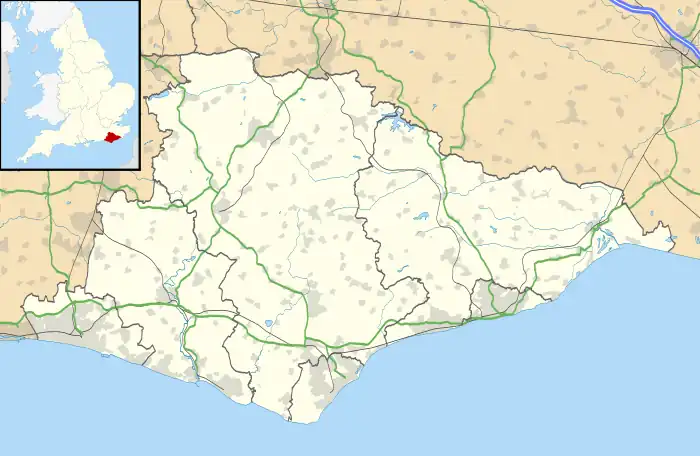| Eastbourne Town Hall | |
|---|---|
 Eastbourne Town Hall | |
| Location | Grove Road, Eastbourne |
| Coordinates | 50°46′00″N 0°16′40″E / 50.7667°N 0.2778°E |
| Built | 1886 |
| Architect | William Tadman-Faulkes |
| Architectural style(s) | Renaissance style |
Listed Building – Grade II | |
| Official name | Eastbourne Town Hall |
| Designated | 24 February 1994 |
| Reference no. | 1043621 |
 Shown in East Sussex | |
Eastbourne Town Hall is a municipal building in Grove Road, Eastbourne, East Sussex, England. The town hall, which is the meeting place of Eastbourne Borough Council, is a Grade II listed building.[1]
History
After significant population growth in the second half of the 19th century, particularly associated with the tourists arriving following the opening of the London, Brighton and South Coast Railway, Eastbourne became a municipal borough in 1883.[2] Civic leaders decided it was necessary to procure a town hall: the site they selected had been occupied by a small local bank known as Stocks Bank.[3][4][5]
The scheme was subject to a design competition which was won by William Tadman-Faulkes but the result was initially set aside on the grounds of cost until agreement was reached that the design work would proceed under the supervision of Henry Currey, architect to the Duke of Devonshire, who was the landowner and instigator of much of the local development at the time.[6] The foundation stone for the new building was laid by Lord Edward Cavendish, the third son of the Duke of Devonshire, on 9 October 1884.[1] It was designed in the Renaissance style, built by a local contractor, James Peerless, and was officially opened by the mayor, Councillor George Boulton, on 20 October 1886.[1][7][8]
The design involved an asymmetrical main frontage with sixteen bays facing onto Grove Road with the end bays slightly projected forwards and topped with mansard roofs; the sixth bay from the left, which also slightly projected forward, featured a portico with four Ionic order columns supporting a parapet and a shield; there was a casement window flanked by Corinthian order pilasters on the first floor, a Diocletian window flanked by more Corinthian order pilasters at attic level and a 130 feet (40 m) two-stage clock tower with a dome above.[1] The clock, which was designed and manufactured by Gillett & Johnston, was installed in 1892,[1] along with five bells (also by Gillett & Johnston) to sound the hours and quarters.[9] Internally, the principal rooms were the council chamber and the mayor's parlour on the first floor as well as the courtroom on the ground floor.[10]
A large crowd and a military parade were present for the proclamation of the accession of King George V which was read out at the town hall on 6 May 1910.[11] In the early 20th century the town hall had its own courtroom and police station and, after the 17-year-old Irene Munro had been murdered by two men, Jack Field and William Gray, on 19 August 1920, it was to the town hall mortuary that her body was taken:[12] Field and Gray were later convicted and hanged for the crime.[13][14]
Queen Elizabeth II, accompanied by the Duke of Edinburgh visited the town hall and signed the visitors book during a tour of East Sussex in 1966.[15][16][17] The town hall continued to serve as the headquarters of Eastbourne County Borough Council for much of the 20th century and remained the local seat of government when Eastbourne District Council was formed in 1974.[18] Works of art in the town hall include a plaster copy of the marble statue by Sir William Reid Dick of Freeman Freeman-Thomas, 1st Marquess of Willingdon which stands in Coronation Park, Delhi.[19] Willingdon was born in Eastbourne and went on to be Governor General of Canada and then Viceroy and Governor-General of India.[20]
See also
References
- 1 2 3 4 5 Historic England. "Eastbourne Town Hall (1043621)". National Heritage List for England. Retrieved 21 December 2020.
- ↑ "Eastbourne Brough Council". National Archives. Retrieved 21 December 2020.
- ↑ "Timeline". Eastbourne Local History Society. Retrieved 21 December 2020.
- ↑ Dougla, Roy (2014). Eastbourne From Old Photographs. Amberley Publishing. ISBN 978-1445633220.
- ↑ Chambers, George F. (1910). "Eastbourne Memories - Of The Victorian Period 1845 To 1901 And Some Other Things Of Interest, Divers". V. T. Sumfield. pp. 27–29.
- ↑ Colin Cunningham (1981). Victorian and Edwardian town halls. Routledge. p. 107. ISBN 978-0-7100-0723-0. Retrieved 19 July 2011.
Eastbourne Town Hall.
- ↑ Surtees, Dr John (2002), Eastbourne, A History, Chichester: Phillimore, ISBN 978-1-86077-226-9
- ↑ Gordon, Kevin (2017). Eastbourne & Around: Unique Images from the Archives of Historic England. Amberley Publishing. ISBN 978-1445675329.
- ↑ "Chimes of the United Kingdom and Ireland". Church Bells of Warwickshire. Retrieved 5 April 2023.
- ↑ "Eastbourne Town Hall". Ceremonies in East Sussex. Retrieved 21 December 2020.
- ↑ "Eastbourne Town Hall: proclamation of King George V". London Evening Stanard. 10 May 1910. Retrieved 21 December 2020.
- ↑ "Story of Lonely Beach Tragedy: How the Body was Found". Daily Herald. 15 December 1920.
- ↑ The Crumbles Story: A Tale of Eastbourne's Colourful Heritage ISBN 978-0-955-34750-4
- ↑ Fielding, Steve (2008). Pierrepoint: A Family of Executioners. John Blake. pp. 110–116. ISBN 978-1-844-54611-4.
- ↑ "Town Hall Tour". Eastbourne Borough Council. Retrieved 21 December 2020.
- ↑ "The day the Queen came to Eastbourne". Eastbourne Herald. 3 August 2020. Retrieved 21 December 2020.
- ↑ "Long live the Queen! Our record breaking monarch". The Argus. 9 September 2015. Retrieved 21 December 2020.
- ↑ Local Government Act 1972. 1972 c.70. The Stationery Office Ltd. 1997. ISBN 0-10-547072-4.
- ↑ "Freeman Freeman-Thomas, 1st Marquess of Willingdon". The Victorian Web. Retrieved 21 December 2020.
- ↑ "Thomas, Freeman Freeman-, first marquess of Willingdon (1866–1941)". Oxford Dictionary of National Biography (online ed.). Oxford University Press. doi:10.1093/ref:odnb/33266. (Subscription or UK public library membership required.)